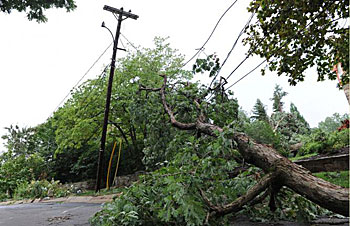By Mike Conrad, Division Chief Operations, Aptos La Selva Fire Protection District

First of all there is no need to worry about Volts, Amps or Ohms that just makes things confusing. We do need to remember that the higher up the electrical pole the wires are the more voltage they carry and these electrical wires are not like an extension cord in your home they are most often bare with no insulation. Also just because a wire is located low on the pole if it is contact with a wire from high on the pole it can still care as much danger as the wire high on the pole.
There are four things that we must always keep in mind when we are faced with down power lines. First is what is called Ground Gradient, this is when an energized power line comes into contact with earth. At the point of contact the ground will become energized with the same voltage as in the wire, this voltage will travel away from the point of contact much like ripples in a pond and as it get further away from the point of contact the voltage decreases. The voltage Gradient can extend for a large distance from the point of contact, the amount of voltage in the line, type of ground, moisture in the soil and humidity can all affect this distance and increase it to 100 feet or more.
The forth thing that you should always keep in mind if you are considering crossing over or touching a down power line, is the reason for doing it worth your life? We see it every winter people walking or driving over power lines because they have to get home to feed the bird, or they can’t be late for work and the list goes on and on. I know that limp piece of wire lying on the ground disrupting your day looks harmless enough BUT, it has the ability to change your life and the life of your family forever in a blink of an eye.
Be safe, enjoy the rain but be careful and stay a safe distance from all down utility lines. For more information please go to the PG&E web site or contact your local fire department.